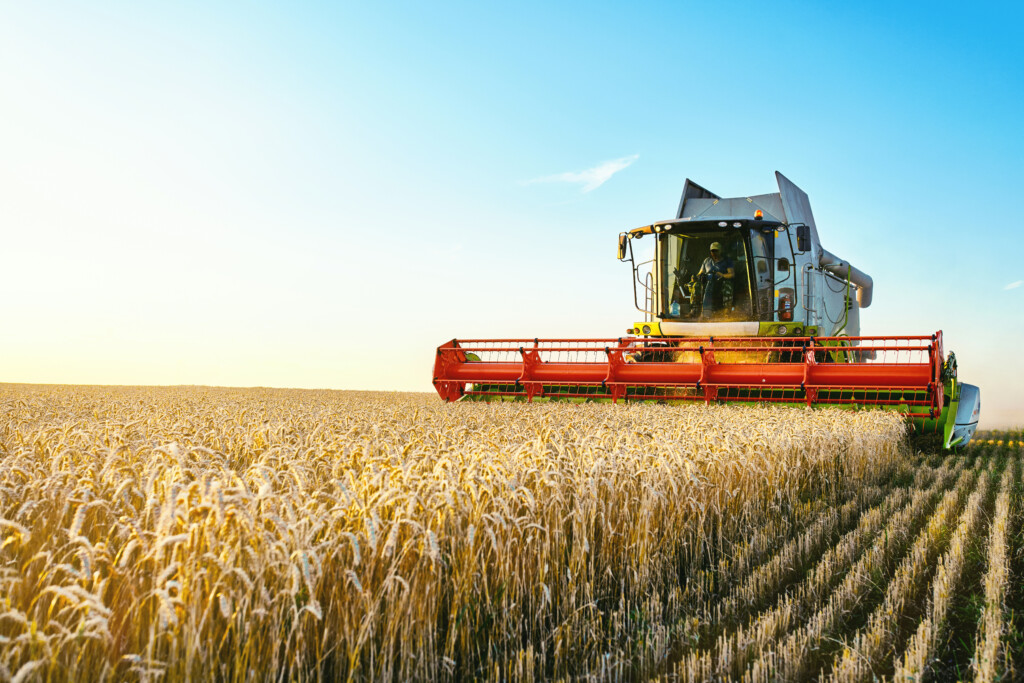Cultivating Collaboration: Keystone’s 50-Year Legacy in Agriculture
For five decades, the Keystone Policy Center has brought people together to find common ground on the toughest issues facing society. Nowhere is that collaborative spirit more evident than in agriculture – a sector where science, stewardship, and livelihoods intersect every day.
From protecting pollinators to pioneering sustainable supply chains and leading global conversations on biotechnology, Keystone’s agricultural work has always reflected a single belief: real progress happens when people come together.
Protecting Pollinators, Strengthening Ecosystems
Keystone’s agricultural story begins with the smallest, yet most vital, workers in our food system: pollinators. As concerns over honeybee health mounted in the early 2010s, Keystone helped launch the Honey Bee Health Coalition, a first-of-its-kind partnership uniting beekeepers, growers, researchers, agribusinesses, and conservationists. Rather than placing blame, the coalition created a trusted space for dialogue and practical action.
Today, it continues to advance science-based strategies to address pests, pathogens, habitat loss, and pesticide exposure, demonstrating how collective action can safeguard both ecosystems and economies.
That same collaborative approach guides Farmers for Monarchs, another Keystone-led initiative. Formed in partnership with agricultural and conservation groups, the project equips farmers and ranchers with resources to establish pollinator-friendly habitat, steward pesticide use, and participate in conservation programs that benefit both crops and butterflies.
When the U.S. Fish and Wildlife Service proposed listing the monarch butterfly as a threatened species under the Endangered Species Act in 2024, Farmers for Monarchs worked tirelessly to keep farmers informed. The collaborative updated farmers on what the proposed rule meant, how to submit public comments, and how agricultural production and conservation could move forward together.
Across both initiatives, Keystone’s role has remained clear: to bridge the space between agriculture and conservation, helping partners find common purpose in protecting pollinators critical to our food supply and natural landscapes.
Defining Sustainable Agriculture: Field to Market
Perhaps no initiative better illustrates Keystone’s model of collaboration than Field to Market. Born in 2006 as a “Keystone Project on Sustainable Agriculture,” Field to Market began with an ambitious question: What does sustainable agriculture really mean and how do we measure it?
Keystone convened farmers, agribusinesses, conservation organizations, and scientists to build trust and define shared metrics. The result was the Fieldprint Platform, a groundbreaking tool that helps farmers measure their environmental footprint and track continuous improvement over time.
“We had conservation groups, companies, and farmers all trying to define sustainability together — not as adversaries, but as partners. Keystone’s ability to convene people and keep them at the table made that possible,” said Glenn Prickett, a trustee of Keystone Policy Center who at the time was working for The Nature Conservancy.
Today, Field to Market is an independent nonprofit organization with hundreds of members and millions of acres enrolled in sustainability programs. Yet it continues to reflect its Keystone roots — uniting diverse stakeholders through dialogue, data, and the shared pursuit of continuous improvement.

CRISPRcon: Advancing Dialogue on Biotechnology and Innovation
As agriculture looks to the future, Keystone’s work has extended beyond the field to the frontier of science.
When CRISPR gene-editing technology emerged, it promised revolutionary possibilities, from improving crop resilience to curing genetic diseases. But it also raised profound ethical and societal questions. To discuss these questions, Keystone was called upon to lead CRISPRcon, an international forum that brings scientists, farmers, ethicists, policymakers, and the public together to explore how society should navigate such powerful technologies.
CRISPRcon’s mission was not to reach consensus, but to broaden understanding and to make participants aware of perspectives they may never have encountered.
Building on CRISPRcon’s success, Keystone also convened the NGO Gene Editing Roundtable, a forum where environmental and consumer organizations collaborated to develop shared principles for responsible governance of gene editing in agriculture and the environment. The group’s work culminated in a peer-reviewed paper in Nature Biotechnology, offering one of the first NGO-driven frameworks for gene editing governance.
Together, these efforts underscore a central truth of Keystone’s mission: that the ethical questions surrounding innovation must be met with the same commitment to dialogue as the innovations themselves.
A Legacy of Collaboration
These are only a few of the initiatives tackled throughout Keystone’s history working in the agriculture sector. Across every initiative — from honeybees to high-tech biotechnology — Keystone’s role has been to listen, convene, and build trust among people with different perspectives. For fifty years, Keystone has shown that progress in agriculture doesn’t come from any single breakthrough, but from the courage to bring people together to ask difficult questions, challenge assumptions, and co-create solutions that endure.
Agriculture will continue to face new pressures, from climate change to technology to shifting consumer expectations. But the Keystone Policy Center’s history offers a steady lesson: when science guides the discussion and trust guides the process, sustainable change takes root.
Explore these and other stories in depth through Keystone’s three-part podcast series on agriculture.


 Effective March 1, 2025, Thomas J. Vilsack, former United States Secretary of Agriculture and Governor of Iowa, became the first Chief Executive Officer for the World Food Prize Foundation. In this new role, Governor Vilsack is focusing on expanding the Foundation’s global network, and will further position the Foundation as a leader in addressing global food and nutrition insecurity, continuing his lifetime of public service.
Effective March 1, 2025, Thomas J. Vilsack, former United States Secretary of Agriculture and Governor of Iowa, became the first Chief Executive Officer for the World Food Prize Foundation. In this new role, Governor Vilsack is focusing on expanding the Foundation’s global network, and will further position the Foundation as a leader in addressing global food and nutrition insecurity, continuing his lifetime of public service. Shelby Coffey III is a distinguished journalist, media executive, and thought leader whose career has helped shape the landscape of American news and public discourse. Over several decades, Coffey has held some of the most influential roles in journalism, including serving as editor of the Los Angeles Times, executive vice president of ABC News, and deputy managing editor of The Washington Post. His editorial leadership extended to key roles as president of CNN Financial News, editor of the Dallas Times Herald, and U.S. News & World Report.
Shelby Coffey III is a distinguished journalist, media executive, and thought leader whose career has helped shape the landscape of American news and public discourse. Over several decades, Coffey has held some of the most influential roles in journalism, including serving as editor of the Los Angeles Times, executive vice president of ABC News, and deputy managing editor of The Washington Post. His editorial leadership extended to key roles as president of CNN Financial News, editor of the Dallas Times Herald, and U.S. News & World Report. Jerry Steiner has spent 40 years involved in agriculture following growing up on a Wisconsin dairy farm. He began his career with Monsanto, in multiple business leadership roles. From 2003-2013 he served as a member of the Executive team, as the company’s Executive Vice President of Sustainability and Corporate Affairs. He led the company’s global Government, Public and Industry Affairs teams across the 70 countries where Monsanto conducts business. This experience got Jerry connected to the Keystones centers work in agriculture. Key among his responsibilities were shaping the company’s public policy and building partnerships aimed at helping farmers around the world produce more food, while conserving valuable resources like water and energy. Two unique partnership that developed under his leadership were drought tolerant corn with 5 African countries, CIMMYT and the Gates foundation, and a building a sustainable business model in Brazil with the value chain leading to significant multi-company investment and soybean varieties that can protected themselves.
Jerry Steiner has spent 40 years involved in agriculture following growing up on a Wisconsin dairy farm. He began his career with Monsanto, in multiple business leadership roles. From 2003-2013 he served as a member of the Executive team, as the company’s Executive Vice President of Sustainability and Corporate Affairs. He led the company’s global Government, Public and Industry Affairs teams across the 70 countries where Monsanto conducts business. This experience got Jerry connected to the Keystones centers work in agriculture. Key among his responsibilities were shaping the company’s public policy and building partnerships aimed at helping farmers around the world produce more food, while conserving valuable resources like water and energy. Two unique partnership that developed under his leadership were drought tolerant corn with 5 African countries, CIMMYT and the Gates foundation, and a building a sustainable business model in Brazil with the value chain leading to significant multi-company investment and soybean varieties that can protected themselves. Jennifer Morris is the Chief Executive Officer of The Nature Conservancy, leading a team of nearly 6,000 staff working in more than 80 countries and territories tackling the dual crises of the
Jennifer Morris is the Chief Executive Officer of The Nature Conservancy, leading a team of nearly 6,000 staff working in more than 80 countries and territories tackling the dual crises of the  Congressman Joe Neguse represents Colorado’s 2nd District in the U.S. House of Representatives. He was elected to his first term in November 2018, becoming the first Black Member of Congress in Colorado history. In December 2022, Rep. Neguse was elected by his colleagues to serve as Chair of the Democratic Policy and Communications Committee (DPCC), becoming the first Coloradan to serve in a senior elected leadership role in the House in over 85 years. He serves on the Natural Resources and Judiciary Committees, and was also appointed by House Minority Leader Hakeem Jeffries to serve as one of four Democrats on the prestigious Rules Committee. Rep. Neguse serves as Ranking Member on the House Subcommittee on Federal Lands, which he previously Chaired in the 117th Congress.
Congressman Joe Neguse represents Colorado’s 2nd District in the U.S. House of Representatives. He was elected to his first term in November 2018, becoming the first Black Member of Congress in Colorado history. In December 2022, Rep. Neguse was elected by his colleagues to serve as Chair of the Democratic Policy and Communications Committee (DPCC), becoming the first Coloradan to serve in a senior elected leadership role in the House in over 85 years. He serves on the Natural Resources and Judiciary Committees, and was also appointed by House Minority Leader Hakeem Jeffries to serve as one of four Democrats on the prestigious Rules Committee. Rep. Neguse serves as Ranking Member on the House Subcommittee on Federal Lands, which he previously Chaired in the 117th Congress. Llewellyn King was born in Southern Rhodesia, now Zimbabwe. He went into journalism as soon as he turned 16, stringing for Time magazine and United Press in Africa.
Llewellyn King was born in Southern Rhodesia, now Zimbabwe. He went into journalism as soon as he turned 16, stringing for Time magazine and United Press in Africa. Steven Williams is the Chief Executive Officer of PepsiCo North America, overseeing a more than $48 billion business that spans PepsiCo’s Foods and Beverage operating units. His leadership encompasses more than 125,000 associates and over 900 locations across the U.S. and Canada. Steven joined PepsiCo in 2001 as part of PepsiCo’s acquisition of the Quaker Oats Company, which he joined in 1997, and has held leadership positions of increased responsibility since.
Steven Williams is the Chief Executive Officer of PepsiCo North America, overseeing a more than $48 billion business that spans PepsiCo’s Foods and Beverage operating units. His leadership encompasses more than 125,000 associates and over 900 locations across the U.S. and Canada. Steven joined PepsiCo in 2001 as part of PepsiCo’s acquisition of the Quaker Oats Company, which he joined in 1997, and has held leadership positions of increased responsibility since.